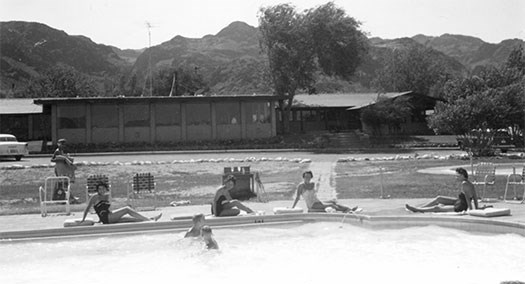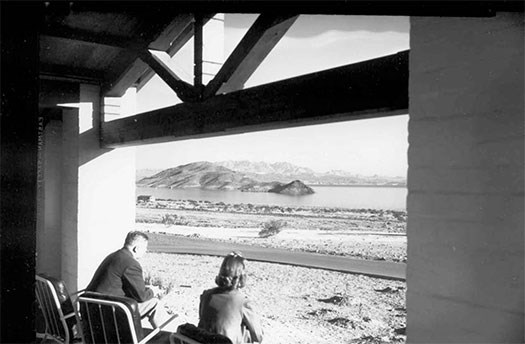|
The Bureau of Reclamation (Reclamation) constructed Boulder Dam (now Hoover Dam) in the 1930s. It was constructed to control the raging waters of the Colorado River, and to provide water and electricity to the growing communities throughout the southwestern United States. Thousands of tourists came to view the construction of the massive dam. Reclamation officials realized that the large lake, Lake Mead, which would be created behind the dam, would also draw thousands of tourists. Reclamation was not set up to manage large numbers of people so they called on the National Park Service (NPS) for help. In 1936, Reclamation turned over management of Lake Mead and the surrounding lands known as the Boulder Dam Recreation Area to the NPS. It became Lake Mead National Recreation Area and a unit of the NPS in 1964. After completion of the Dam, tourism continued to grow and the NPS signed a 20-year contract with Grand Canyon-Boulder Dam Tours, Inc. (GCBDT). The contract gave GCBDT exclusive rights to construct and operate tourist facilities around Lake Mead under the supervision of NPS. GCBDT already managed facilities in Boulder City, the closest community to Lake Mead. Under this contract, GCBDT built Hualapai Lodge, named for a Native American tribe in Arizona east of Lake Mead. Opened in 1941, Hualapai Lodge played a key role in the development of recreation and tourism at Lake Mead National Recreation Area and Southern Nevada. The Lodge was the first hotel on Lake Mead, and it was one of the first tourist facilities constructed inside the park. Boulder Beach was chosen as the site for the new hotel due to its proximity to a long sandy beach, boat launch, and the growing town of Las Vegas. Water and sewer connections also already existed in the Boulder Beach area. 
Initial plans called for the construction of individual cottages, but eventually three larger lodge units were built to save on construction and utility costs. The building design contained elements of Spanish-style architecture, as well as other styles. Each guest room had its own heating and cooling units. The Lodge opened two months before the bombing of Pearl Harbor. Tourism into the area dropped substantially during the war years, however locals patronized the Lodge--gathering nightly to dine, enjoy a drink and dance at the area's only bar, as alcohol sales were banned in Boulder City. 
The facility was renamed Lake Mead Lodge in 1945, since the name better reflected its lakeside location and was easier to spell and pronounce than "Hualapai." GCBDT was having financial problems because of the decline in tourism during World War II, and in 1948 they subcontracted operation of Lake Mead Lodge to Continental Hotel Systems. With the impending expiration of the initial 20-year contract to operate the Lodge, the NPS looked to have new requirements inserted into the new contract. These requirements were more than GCBDT wanted to undertake, and in 1954 Continental Hotel Systems took over management of the Lodge. The new operator constructed a large swimming pool, small wading pool, and a fourth lodge building to better serve the growing number of tourists visiting Lake Mead. Tourism to Southern Nevada grew continually in the 1950s and 1960s and new hotels and other tourist facilities sprang up around the area. During this period Lake Mead continued to gain popularity, with over 2,000,000 visitors coming to Boulder Beach each year in the 1950s. To help meet the needs of exploding visitation at National Parks across the country, an initiative called Mission 66 funded new facilities throughout the National Park system. The goal was improving park facilities by the Agency's 50th birthday in 1966. Under this initiative, Lake Mead National Recreation Area built new boat ramps, campgrounds, picnic areas, ranger stations, a visitor center and employee housing. The Mission 66 era also saw new overnight accommodations built at Temple Bar and Echo Bay on Lake Mead, and Willow Beach, Cottonwood Cove and Katherine Landing on Lake Mohave. The McCullough Corporation took over management of Lake Mead Lodge in 1961. McCullough also acquired management of the nearby Lake Mead Marina where they constructed the world's largest floating restaurant. Because of its close proximity to this fancy new floating restaurant, the restaurant and bar at Lake Mead Lodge were closed. Still, the combination of boat rentals, beach and overnight facilities ushered in the heyday of the Lake Mead Lodge, and it became a favored destination for Las Vegas celebrities such as Don Rickles, Andy Williams and Harry Belafonte, who regularly chartered boats from the marina. 
Management of the Lodge again changed hands in the 1970s, first going to Leisurama and later to Lake Mead Resort. Lake Mead Resort made several minor modifications to the lodge grounds, including adding gazebos, rope fences, lamp posts and palm trees. The wading pool was filled in the early 1980s. In 1987 the company name was changed to Seven Crowns Resorts. Lake Mead National Recreation Area has become one of the nation's most popular park units, attracting over seven million visitors per year. Las Vegas and Southern Nevada attract visitors from around the world, and the widest possible array of high-quality tourist accommodations are now found in Las Vegas, Henderson, and Boulder City. In 2008, Lake Mead Marina was moved 3 miles to the south because of dropping lake levels. The moving of the marina isolated Lake Mead Lodge from their marina visitors and the number of overnight guests staying at the Lodge dropped considerably. Seven Crowns Resorts made a business decision to not renew their contract with the NPS to operate the Lodge. After over 65 years of serving the needs of tourists, Lake Mead Lodge was closed in 2009. The NPS began the process of determining what to do with the Lodge. Current federal law requires the NPS to determine if overnight facilities in the Boulder Beach area are necessary and appropriate. The NPS analyzed the variety of overnight accommodations in the cities surrounding Boulder Beach, and determined that visitors could easily access the Boulder Beach area from reasonably priced overnight accommodations in Boulder City, Henderson or Las Vegas. 
Because the Lodge was over 50 years old it was potentially eligible for the National Register of Historic Places (NRHP). The NPS researched the historical significance of the Lake Mead Lodge and prepared two documents, a National Register of Historic Places Registration Form and a Historic American Building Survey report for the Lodge. The NPS consulted with the Nevada State Historic Preservation Office (SHPO) and determined that the Lodge was eligible for the NRHP because of its role in the development of recreation and tourism at Lake Mead and in Southern Nevada. The NPS then undertook a series of studies to determine whether the Lodge buildings could be adapted for other uses. Numerous planning meetings were held, and options as varied as using the facility for employee housing, office space, a training center and an environmental education center were evaluated. Unfortunately the Lodge buildings were constructed prior to today's construction, safety and accessibility codes, and many costly upgrades would be needed to bring them up to modern codes. The Lodge buildings also suffered from decades of deferred maintenance, and it was determined to be unfeasible to reuse the Lodge buildings for any purpose. Throughout this process the NPS consulted with the SHPO as required by the National Historic Preservation Act. A final decision was made in 2012 to remove the buildings and restore the grounds to natural desert. Removal of a facility that is eligible for listing on the NRHP is considered an "adverse effect" under the National Historic Preservation Act; therefore, the NPS developed a plan in consultation with the SHPO to mitigate the adverse effect caused by removal of the Lodge. Specific mitigation measures include creation of educational materials including this website and an exhibit located at the Lodge site, archiving all of the information related to the history of the Lodge in the park's collection facility, and making The National Register of Historic Places Registration Form and The Historic American Building Survey report for the Lodge available to the public. Lake Mead Lodge's history reflects the growth of tourism and outdoor recreation in Southern Nevada. The Lodge served the growing demands of postwar visitors, and provided reasonably priced lodging in a beautiful lake setting until it closed in 2009. |
Last updated: February 26, 2019
